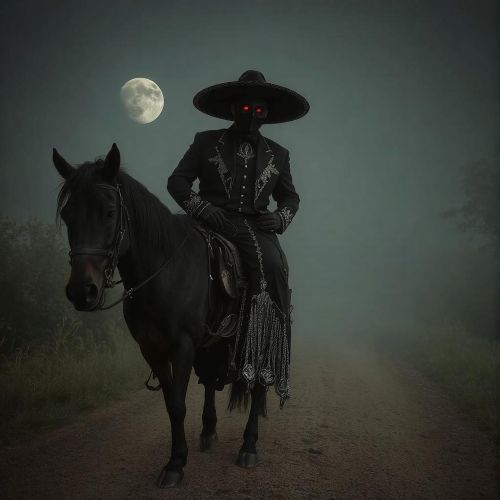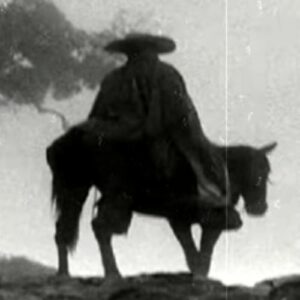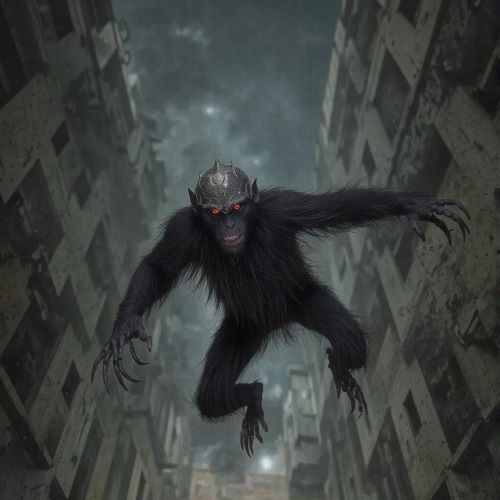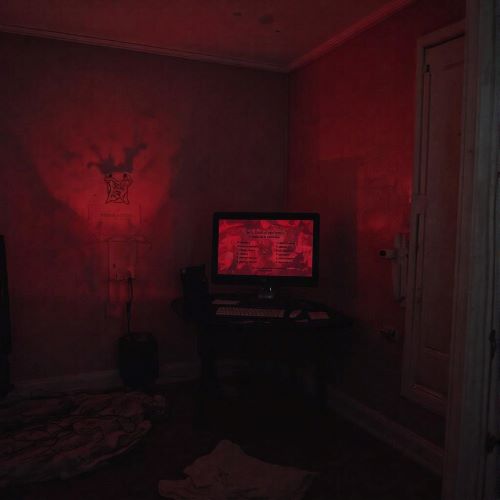
El Charro Negro : The Black Horseman
| Description | |
|---|---|
| Origin | Mexico |
| Classification | Humanoid |
| Demeanour | Evil |
| Habitat | Highways |
| Status | Not Proved |

Introduction
El Charro Negro, often translated as “The Black Horseman,” remains one of the most haunting figures in Mexican folklore. Deeply embedded in stories passed down since colonial times, this ghostly rider represents more than just a terrifying encounter; he is a symbol of temptation, greed, and the ultimate price one might pay for desiring wealth at any cost. Often encountered alone on shadowy backroads, he appears with promises of riches, only to lead the greedy and the unwary to their doom. The legend of El Charro Negro serves as a chilling reminder that not all that glitters is gold—and some gold is cursed.
Physical Attributes
Descriptions of El Charro Negro are striking and deeply rooted in the traditions of Mexican culture. He is almost always seen in an impeccable black charro suit, complete with intricate silver embroidery and a wide-brimmed hat that veils his face in shadows. His presence is elevated by the fearsome steed he rides—a black horse with glowing red eyes and steam pouring from its nostrils, even on warm nights. Some versions of the legend describe the rider’s eyes as burning coals and, at times, depict his face as skeletal or completely featureless. The eeriness of his appearance is designed to unnerve, creating an image that lingers long after the tale is told.
First Sighting/Reporting
Though it is impossible to trace the origin of the legend to a specific date, stories of El Charro Negro gained traction during and after the Mexican colonial period. Folktales often situate his appearances in towns rich in minerals or heavily impacted by social inequality, where desperation made people more likely to consider Faustian bargains. One widely known account tells of a miner whose deal for gold cost him not just his soul but the lives of his children. His funeral was disrupted by El Charro himself, who arrived to claim what was owed. In a separate, more modern incident from 1966 in Veracruz, a man named Don Abundio reportedly encountered the spectral rider. Refusing his cursed gold, he escaped with his life but was forever haunted by the experience. As recently as April 2025, surveillance footage from Mexico stirred speculation when it captured a dark figure on horseback disappearing into thin air on a quiet urban street.
Other Names
El Charro Negro is most commonly referred to by that name throughout Mexico, but the legend evolves and morphs across different regions. In Mazatec beliefs, he is known as San Martín de Caballero, a spectral guardian of hidden treasures who punishes the greedy. Among the Mixtec people, he is called Señor del Cerro, a mountain spirit with a strong moral code. The Huichol community refers to a similar figure as Tamatsi Teiwari Yuawi, a symbol of colonial-era trauma who represents dark mestizo forces. These varying names reflect the adaptability of the legend and its ability to absorb local beliefs, thus maintaining relevance across cultural lines.
Modus Operandi
The eerie pattern of El Charro Negro’s appearances is consistent throughout the many retellings. He tends to show up at twilight or under a full moon, primarily targeting lone travelers on rural paths or deserted town streets. His most frequent approach involves offering a bag of gold or a lavish ride on his magnificent horse. Accepting either offer is believed to initiate a pact, often with dire consequences. Victims might find themselves unable to get off the horse, or watch the gold they received turn into useless debris like leaves or manure. Those who accept his hospitality too eagerly often disappear, their fates unknown. Sometimes he is said to seduce women or deceive men with promises of fortune, always ending in misfortune. Unnatural sounds—like disembodied bells or hoofbeats that vanish mid-echo—often signal his presence.
Pop Culture References
El Charro Negro has made a seamless transition into Mexican pop culture, appearing in everything from cinema to music. In 2018, the animated film La Leyenda del Charro Negro introduced him to a younger generation. Part of the Las Leyendas film series, the movie centers on young hero Leo San Juan and his attempt to save a friend from the underworld. Earlier portrayals, like the 1940 film El Charro Negro, present more traditional interpretations of the legend. Musicians have also drawn inspiration from him—most notably African-American singers Timoteo and Bobby Butler, who embraced the name as part of their performance personas, combining traditional Mexican music with their own unique backgrounds. In literature, collections of Mexican myths and horror anthologies regularly feature the character, keeping his legend alive in the pages of books. In the digital realm, he has become a recurring figure in spooky TikTok videos and eerie YouTube stories, furthering his reach into the modern imagination.
Current Status
Source
Haunted Diary. (2023, December 16). El Charro Negro: A chilling Mexican legend and a cautionary tale. https://haunteddiary.com/el-charro-negro-chilling-legend-or-a-warning-against-greed/
DMexico. (2019, November 21). El Charro Negro: The ghost of the Mexican Revolution that terrified the entire country. https://dmexico.com/history/el-charro-negro-the-ghost-of-the-mexican-revolution-that-terrified-the-entire-country-1255/
Dos Mundos. (2023, October 20). Hispanic hauntings: The legend of El Charro Negro. https://dosmundos.com/2023/10/20/hispanic-hauntings-the-legend-of-el-charro-negro/
Señor Scary. (2022, October 31). El Charro Negro. https://www.senorscary.com/post/charronegro
Monster Wiki. (n.d.). Charro Negro. https://monster.fandom.com/wiki/Charro_Negro
Villains Wiki. (n.d.). El Charro Negro (folklore). https://villains.fandom.com/wiki/El_Charro_Negro_%28folklore%29





